The Modulation Effect of Chinese Medicines
According to the concept of immunology, no matter if the immune reaction belongs to physiological or pathological factors, all the developing factors are crucial to disease formation. The basic rule for curing immune diseases is to shift the pathological immune reaction to a normal physiological immune reaction. In TCM, it is expressed by regulating the yin and yang balance, by applying holistic approaches to enhance the system's harmony, a method called dual modulation. Certainly, the immune modulation effect of Chinese medicine is extremely complicated, only a preliminary understanding has been revealed at this moment. Below are a few areas of discovery.
Modern research shows that the majority of individuals suffer from syndromes of deficiency, various degrees of under-functioning or a disturbance of their immune system.(2) Correspondingly, most of the tonifying herbs applied to these conditions can enhance immune function. For example, herbs like Lingzhi, ginseng, Tang shen, milk vetch root (huang qi), large head artactylodes rhizome (bai zhu), deer antler and Chinese caterpillar fungus, Chinese angelica (dang gui) and Barbary wolfberry fruit (gou qi zi) enhance the engulfing activities of monocytes, promote T- lymph cells' activation, increase the NK cells' activation and specific antibody productions and induce interferon reactions.(2) Tonifying herbs that are blood builders like Barbary wolfberry fruit (qi zi), fleece flower root (shou wu), donkey hide glue, rehmannia root (di huang), Chinese angelica (dang gui) and deer antler enhance blood production in the bone marrow (immune organ) significantly. They can be used as adjuvant therapy in leucopenia (low level of white blood cells) conditions caused by radio or chemotherapies, or some autoimmune blood diseases.(2)
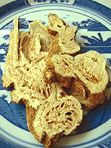 |
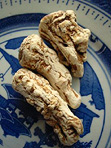 |
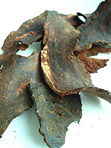 |
| Large head artactylodes rhizome (bai zhu) enhances the engulfing activities of monocytes and promotes T- lymph cells' activation. |
Chinese angelica (dang gui) promotes the NK cells' activation and specific antibody production. |
Fleece flower root (shou gui) enhances blood production in the bone marrow. |
In the herbal category for heat clearing, many herbs promote immune function or the body resistance. Meanwhile, they also inhibit certain adverse immune reactions that are harmful to the body. For example, herbs like Baical skullcap root (huang qin), honeysuckle flower (jin yin hua), wormwood (qing hao) and Trichosanthes root (tian hua fen) inhibit hypersensitivity significantly.(2) Some of them also induce the production of interferon or tumor necrosis factor.(2) Enhancement of the pituitary- adrenal cortex can also be done with this category of herbs such as Spreading hydyotis (bai hua she she cao), Ningpo fogwort (xuan shen), Andrographis (chuan xin lian) and Northern ash bark (qin pi).
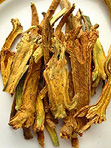 |
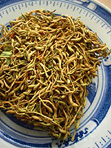 |
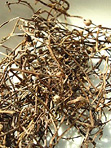 |
| Baical skullcap root (huang qin) inhibits hypersensitivity significantly. |
Honeysuckle flower (jin yin hua) induces the production of interferon. |
Spreading hydyotis (bai hua she she cao) enhances the functions of the pituitary- adrenal cortex. |
Besides the benefit of improving the cardiovascular system and dynamic blood activities, some herbs used for blood and circulation also possess important effects on immune regulation. Herbs like notoginseng, achyranthes (niu xi), Dan shen, Szechuan Lovage (Chuan xiong), peach kernel (tao ren) and Argy wormwood leaf (ai ye) increase T-lymph cells and promote specific antibody production.(2) Some other herbs like notoginseng and madder (qian cao) promote blood production in the bone marrow too.(2)
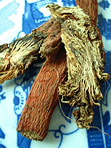 |
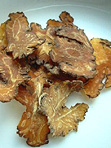 |
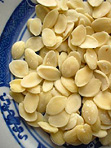 |
| Dan shen increases T-lymph cells. |
Szechuan Lovage (chuan xiong) promotes specific antibody production. |
Peach kernel (tao ren) is commonly used for blood and circulation in TCM. |
Main effect of herbs in the category for expelling wind and relieving syndromes of exterior type, are on the body's immune barriers, such as skin, respiratory mucosa, or localized body fluids and cell immune functioning. For example, some of them enhance the engulfing actions of phagocytes, like Divaricate Saposhnikovia root (fangfeng), cassia twig, Perilla leaf (su ye), fresh ginger and Chinese tororwax root (chai hu).(2) However, some herbs also act directly on the immune organs.
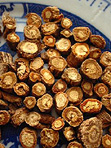 |
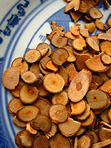 |
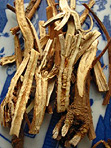 |
| Fangfeng enhances the engulfing actions of phagocytes. |
The main effect of cassia twig is on the body's immune barriers. |
Chinese tororwax root (chai hu) is commonly used for relieving syndromes of exterior type in TCM. |
It is well known that Chinese drugs used for rheumatism possess significant immune inhibiting effects. Herbs used to treat this condition include Oriental vine stem (qing feng teng), Tripterygium (lei gong teng) and Northern fangji (Radix Stephaniae Tetrandrae). Other herbs that inhibit multiple hypersensitivity reactions are Paniculate Swallowwort root (xu chang qing), Slenderstyle Acanthopanax bark (wu jia pi) and Largeleaf gentian root (qin jiao).(2)
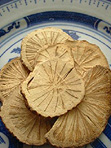 |
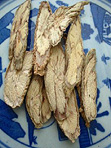 |
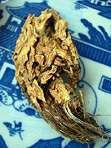 |
| Northern fangji has immune inhibiting effects. |
Slenderstyle Acanthopanax bark (wu jia pi) inhibits multiple hypersensitivity reactions |
Largeleaf geatian root (qin jian) is commonly used for rheumatism in TCM. |
Chinese herbs that possess anti-cancer effects can depress or kill cancer cells by inducing certain immune actions. Such herbs are natural indigo, Java Brucea fruit (ya dan zi), sweet melon pedicel and Chinese fir.(2) Some of these herbs even boost the overall immune functions, such as toad venom, Java Brucea fruit (ya dan zi), blister beetle (ban mao), natural indigo and sweet melon pedicel.(2) Also, some herbs like garlic can help reduce carcinogenic factors.(2)
Most Chinese medicines are natural substances that remain in their natural form when used for treatment. After being tested and verified for thousand years by Chinese medicine practitioners, those left behind have proven their effects. Scientists have noted multiple efficacies of these prescriptions which have dual modulation and adaptive capabilities. However, even in the study of immune modulation, projects for Chinese medicine are huge and complex, and the current overall research work has not been systematic. Among those single herbs or formulas, it is necessary to carry out more in depth investigations for further explanation about the mechanism of how these herbal ingredients work.
References
| 1. |
He Huai-xin & Xi Xiao-xian, TCM Immunology, Beijing: Publishing House of People's Military Hospital, May 2000. |
| 2. |
Luo He-sheng, Luo Ding-hui & others, TCM Immunology: Chinese Medicine Pharmacology and Clinical Practice, Beijing: Joint Publishing House of Beijing Medical College and Beijing Union Medical College, April 1999. |
| 3. |
Yu chuan-lin, Ye Tian-xing & others, Modern Medical Immunology, Publishing House of Shanghai Medical University, October 1998. |
| 4. |
Kou Hua-sheng & Lin Jian-yu, TCM Immunology, Wuhan: Hubei Publishing House of Science and Technology, June 1990. |
Written By:
Wang Li
Professor, Beijing University of Chinese Medicine
Editors:
Angela Collingwood, MSN, Integrated Chinese Medicine Holdings Ltd.
Lawrence Lau, Ph.D., Integrated Chinese Medicine Holdings Ltd.
Rose Tse, Integrated Chinese Medicine Holdings Ltd.
Special thanks to Elpidio Talens Juan for helping with article graphics. |